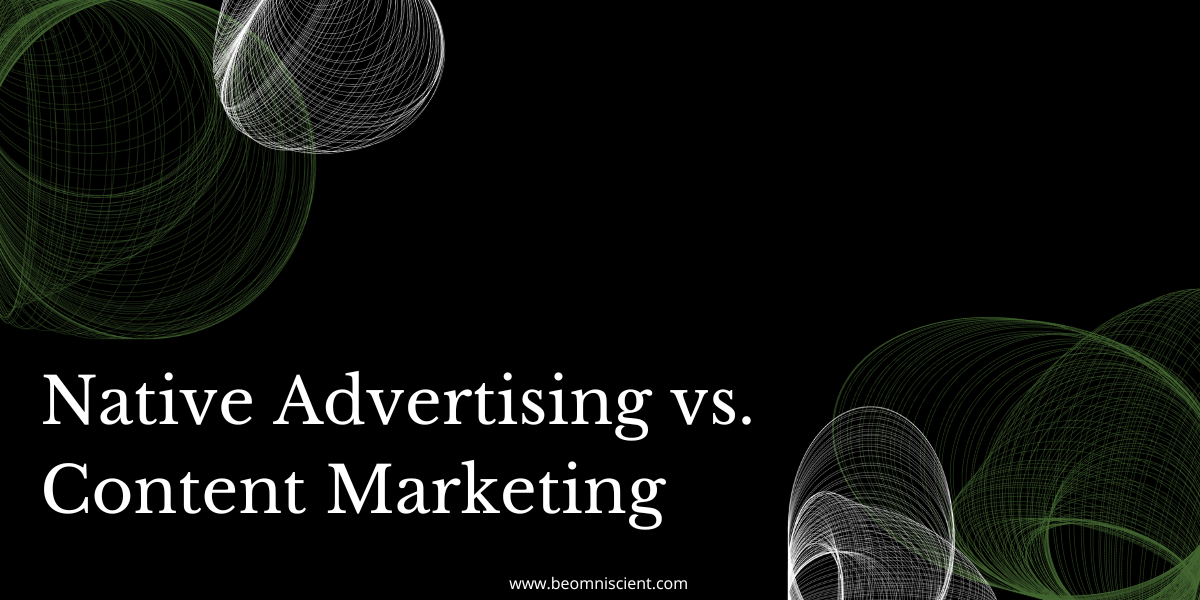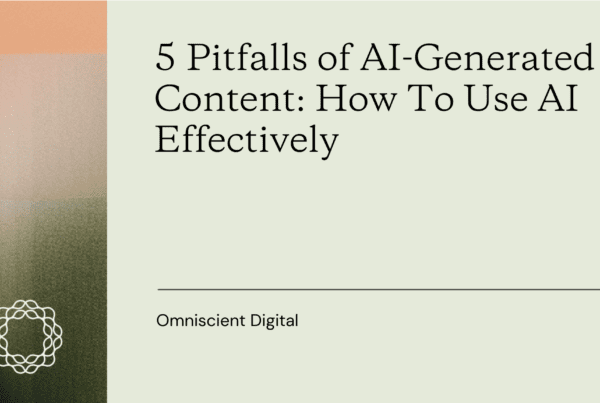
Organic reach is no longer what it once was.
Social media and search engine optimization has officially become too congested and noisy.
To simply rank your blog at #1 in Google or reaching a statistically significant data set with organic social media is a huge feat. And the painful reality is that unless you go “viral” or are relying on over a decade of content marketing–growing your brand online is an uphill battle.
This is why over the past few years, native advertising has emerged as a hugely popular alternative. It blends together the appearance of organic content and the widespread exposure of paid advertising. And it’s clearly very effective.
However the question still stands: would we be better off prioritizing native advertising over content marketing? In this article we’ll explore both approaches, weigh them against each other and help you to figure out which is best for your business.
So without further ado, let’s get started!
What is Native Advertising?
Native advertising refers to a discrete type of online advertising that blends into its native environment–usually with a label like “ad” or “sponsored.” This approach aims to create a more harmonious user experience and enhance engagement compared to traditional advertising.
Rather than just create generic banner ads that command the reader to “buy my product now”, native ads are much more intelligent and tactile. They tiptoe around ad blockers and banner blindness with a modicum of grace.
In many instances, they’ll emulate organic content through the use of funny memes, high-quality HEVC video and eye-catching headlines.
(It’s worth noting that In 2023, native advertising has pretty much become synonymous with most digital advertising campaigns.)
There are four main types of native ads:
- In-Feed Ads:
In-feed ads (AKA social ads) seamlessly integrate within the content feed of a platform, such as social media feeds or news websites. They appear as sponsored posts, articles, or videos, blending in with the surrounding content and capturing users’ attention as they scroll through their social media posts.
The whole point of in-feed ads is to avoid disrupting the flow of a viewer’s online experience. You can find them readily on all of the social apps: Twitter, Facebook, Instagram, LinkedIn, Tiktok and Reddit.
- Search Ads
Search ads are native advertisements that appear alongside organic search results on search engine result pages (SERPs). They are designed to match the look and feel of the search results, making them appear more relevant and trustworthy to users.
Search ads can be found on search engines like Google, Bing, and Yahoo. Using a Google Ads reporting tool allows you to track the performance of these ads, providing valuable insights to optimize your campaigns.
- Recommendation Widgets
Recommendation widgets are native ads that appear as content recommendations within web pages or mobile apps. They typically feature a list of suggested articles, products, or services based on the user’s browsing behavior or interests.
Marketers can leverage recommendation widgets on various platforms, such as content discovery platforms like Taboola and Outbrain while using marketing mix modeling to fine-tune their placements for better ROI.
Side note: If you’re anything like me, you’re probably wondering whether Taboola is just a scammy clickbait site full of anti-aging hacks.
I did a little digging and here’s a clearer explanation from their website:
“Taboola is the world’s largest discovery platform. Through our exclusive partnerships with many of the world’s top publishers, we serve 360 billion content recommendations to over one billion people across the web each month. You have probably seen our feed serving recommendations on sites like Bild, Bloomberg, NBC News, Le Figaro, MSN, The Independent and The Weather Channel.”
- Promoted Listings
Promoted listings are native ads commonly found on e-commerce platforms and online marketplaces. They appear as sponsored product listings within search results or category pages, showcasing products or services alongside other relevant offerings.
Promoted listings can be found on platforms like Amazon, eBay, and Google Shopping.
- The Key Benefits of Native Advertising
Here are a few reasons you may want to consider including native advertising into your marketing mix:
- Priority Attention
Instead of having to go through the slog of building an organic presence–native ads get you special treatment.
As the online landscape gets more competitive, native advertising is one of the main ways of getting your brand noticed–particularly SMEs.
Did you know, for example, that 68% of marketers stated that paid advertising is “very important” or “extremely important” to their overall marketing strategy.
What exactly does this mean?
Well, let’s say that you are a headphone brand. You want your website to show up for the term “best noise cancelling headphones” in the Google SERPs.
According to Ahrefs, you’d need 329 backlinks!
For competitive high purchase-intent keywords, paid advertising is likely the only way you’ll even begin to show up on the radar.
- Granular Targeting
Native ads can be precisely targeted based on factors such as demographics, interests, and browsing behavior. For instance, if your company operates in UAE, specifically in Dubai, advertising companies in Dubai can use native ads to target local audiences interested in their services and reach potential clients within the region.
This targeting capability allows businesses to deliver their messages to the most relevant audience, increasing the chances of conversions and driving better results.
Just take Facebook, for example. They allow you to target the most specific demographics and psychographics.
Instead of just posting to your facebook followers, a well-placed Facebook ad can directly approach female bakers, aged 29-38, with a passion for entrepreneurship, who’ve previously viewed your facebook page. Not too shabby!
Top tip: You can take this one step further by A/B testing the copy and visuals of your ads. Just like Hubspot has here:
- Widespread Exposure
Native advertising offers various formats and placements to suit different marketing goals and platforms. These can include in-feed ads, search ads, recommendation widgets, promoted listings, and more. This flexibility allows businesses to tailor their native ads to the specific needs of their target audience and platform.
One of the great advantages of recommended widgets, like Taboola for example, is that they place your advertising message on dozens of high-traffic websites. Instead of guestposting on each individual editorial site, it goes live everywhere, at once, within just a few clicks.
Furthermore if you’re promoting gated content, like Hubspot’s LinkedIn eBook above, native advertising can do the heavy lifting–getting it in front of the right readers at the right time.
- What is Content Marketing?
Content Marketing takes an inbound approach to getting your brand seen. In 2023, this means prioritizing your owned media, customer reviews and catalog of educational content.
Rather than try to actively sell your products, content marketing is about building relationships and establishing yourself as a thought leader in your niche. By positioning your brand as a go-to-resource, prospects will immediately think of you when the time comes to buy.
Most content marketing operations include:
- The Key Benefits of Content Marketing
Here are a few reasons you may want to consider doubling down on your content marketing efforts:
- Customer Trust
When you consider your favorite brands, I’d hazard a guess that they invest heavily into organic content. Why? Because native advertising exploits attention; while content marketing earns it.
The reason why folks like Kylie Jenner and MrBeast have become billionaires in their early-twenties is because they understand the importance of cultivating an audience. In a world where we’re exposed to upwards of 347 advertisements a day (highly conservative estimate)–they offer content people actually want to watch.
While ads have their utility, building genuine relationships with your customers is perhaps the greatest differentiation strategy.
- Cost-Effective Repurposing
Once you’ve done the tricky work of creating a valuable content asset–you can repurpose it to reach entirely new audiences. A podcast becomes a YouTube clip; a whitepaper becomes an Instagram infographic; a Reddit post becomes a Twitter thread.
And just think: you don’t have to assign a whole new PPC budget. Providing that you’re willing to build your online presence on each platform, your content assets will begin to cross-pollinate all driving traffic back to your website.
- Long-Term Results
Content marketing is a long game, but, if you can stick it out there results can be exponential.
What does this mean exactly? Here’s how Ahrefs explains the value of organic traffic:
“Organic Traffic value is the estimated monthly cost of traffic from all keywords a site is ranking for if paid via PPC.”
This means that instead of paying a recurring monthly cost to retain the same level of attention–it’s effectively free. And, as your articles begin to rank for multiple keywords, this value can become staggering.
Just take a look at the long-term value of Ahrefs’s content efforts:
- Native Advertising vs Content Marketing: A Side-By-Side Comparison
While there are many important considerations between both content marketing and native advertising, here’s a useful starting point:
The Barbell Approach: The Best of Both Worlds?
When it comes to native advertising versus content marketing, there is no singular right or wrong option. The choice between these strategies depends on your unique assets, timeframe, and marketing objectives.
Personally however, I’d argue that if you’re considering native advertising, it’s worth applying the Barbell approach.
In basic terms, it means that you spend 90% of your resources creating organic content and 10% advertising the campaigns relevant to your marketing goals.
Once you’ve got an intuitive grasp over which content assets appear to be resonating–you can give them that extra nudge with ad spend.
The beauty of the Barbell approach is that it combines the advantages of both strategies:
- Focusing the majority of your efforts on organic content creation, you can tap into the power of compounding growth and establish a strong foundation of credibility.
- Allocating a portion of your resources to native advertising allows you to maximize your reach, increase visibility, and generate a high-risk, high-reward scenario.
Conclusion: Which Strategy is Best?
Ultimately, the decision between native advertising and content marketing depends on your specific digital marketing goals.
The way native advertising works for a large tech company–with deep pockets–obviously won’t suit small SaaS brands. And the guerilla outreach tactics of a feisty startup may not suit Hubspot, particularly if they can pay for immediate results instead.
Native advertising is like taking a shortcut to your destination; it’s only valuable if you know where you’re heading. If you don’t figure out what your audience cares about prior to advertising, you’re burning a hole in your pocket.
However by prioritizing organic content, you develop a solid foundation to promote the top performing assets. So rather than being an either/or, it really is about content marketing AND native advertising.
Remember, there is no one-size-fits-all answer. Evaluate your business objectives, resources, and audience preferences to determine the optimal blend of paid content and content marketing that will propel your business forward.


